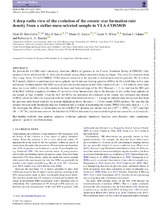| dc.contributor.author | Malefahlo, Eliab D. | |
| dc.contributor.author | Jarvis, Matt J. | |
| dc.contributor.author | Santos, Mario G. | |
| dc.contributor.author | White, Sarah V. | |
| dc.contributor.author | Adams, Nathan J. | |
| dc.contributor.author | Bowler, Rebecca A. A. | |
| dc.date.accessioned | 2022-02-21T10:08:39Z | |
| dc.date.available | 2022-02-21T10:08:39Z | |
| dc.date.issued | 2022 | |
| dc.identifier.citation | Eliab D Malefahlo, et al. 2022. A deep radio view of the evolution of the cosmic star formation rate density from a stellar-mass-selected sample in VLA-COSMOS, Monthly Notices of the Royal Astronomical Society, Volume 509, Issue 3, January 2022, Pages 4291–4307, https://doi.org/10.1093/mnras/stab3242 | en_US |
| dc.identifier.uri | https://doi.org/10.1093/mnras/stab3242 | |
| dc.identifier.uri | http://hdl.handle.net/10566/7287 | |
| dc.description.abstract | We present the 1.4 GHz radio luminosity functions (RLFs) of galaxies in the Cosmic Evolution Survey (COSMOS) field, measured above and below the 5σ detection threshold, using a Bayesian model-fitting technique. The radio flux densities from Very Large Array (VLA)-COSMOS 3-GHz data are extracted at the position of stellar-mass-selected galaxies. We fit a local RLF model, which is a combination of active galactic nuclei and star-forming galaxies (SFGs), in 10 redshift bins with a pure luminosity evolution model. Our RLF exceeds previous determinations at low radio luminosities at z < 1.6 with the same radio data, due to our ability to directly constrain the knee and faint-end slope of the RLF. Beyond z ∼ 2, we find that the SFG part of the RLF exhibits a negative evolution (L* moves to lower luminosities) due to the decrease in low stellar-mass galaxies in our sample at high redshifts. From the RLF for SFGs, we determine the evolution in the cosmic star formation rate density (SFRD), which we find to be consistent with the established behaviour up to z ∼ 1 using far-infrared data, but exceeds that from the previous radio-based work for the reasons highlighted above. Beyond z ∼ 1.5 the cosmic SFRD declines. We note that the relation between radio luminosity and star formation rate is crucial in measuring the cosmic SFRD from radio data at z > 1.5. We investigate the effects of stellar mass on the total RLF by splitting our sample into low (108.5 ≤ M/M⊙ ≤ 1010) and high (M>1010M⊙) stellar-mass subsets. We find that the SFRD is dominated by sources in the high stellar masses bin, at all redshifts. | en_US |
| dc.language.iso | en | en_US |
| dc.publisher | Royal Astronomical Society | en_US |
| dc.subject | Astronomy | en_US |
| dc.subject | Galaxies | en_US |
| dc.subject | Evolution | en_US |
| dc.subject | Luminosity | en_US |
| dc.subject | VLA-COSMOS | en_US |
| dc.subject | Deep radio view | en_US |
| dc.title | A deep radio view of the evolution of the cosmic star formation rate density from a stellar-mass-selected sample in VLA-COSMOS | en_US |
| dc.type | Article | en_US |

